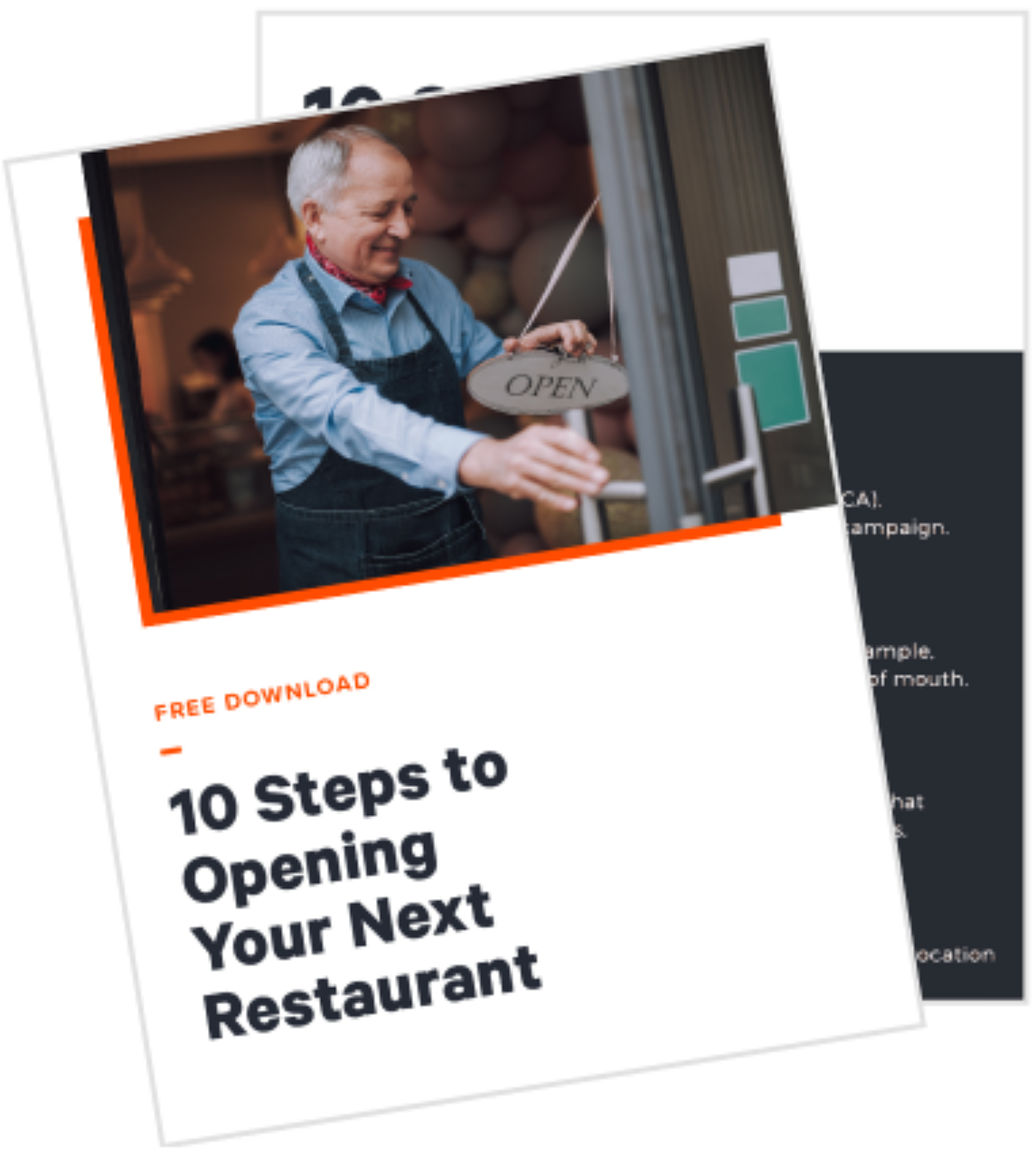
How to Expand Your Restaurant Business
Learn the steps needed to expand your restaurant business, from customer analysis to business plan to grand opening and beyond.

Allie Van DuyneAuthor


The Restaurant Expansion Checklist
Learn how to expand into your second, fifth, or tenth restaurant location.
Get free downloadYour restaurant sales are booming. Your staff are happy. And your guests are providing some good word-of-mouth buzz about your place.
So, naturally, you’re wondering where to go from here. Restaurant expansion could be in the cards, though consultants might tell you to focus on perfecting your current setup and slowly preparing to grow: testing new menu items, new design concepts, and new processes at your current restaurant before jumping into a new venture.
But if you feel that you're comfortable with the costs to open a restaurant and ready to start your next location, whether it's your second, third, or 10th - there are some basics of expanding a restaurant business that every owner should know.
More than 70,000 restaurants closed their doors for good due to COVID, and some would guess that the ones left standing wouldn't be too keen on taking the risks associated with expansion. But many restaurant owners and operators across the country are using this unusual time to open new locations, often experimenting with new concepts like ghost kitchens, buy online, pickup in store (BOPIS), and other grab-and-go options.
Former President of the Massachusetts Restaurant Association Peter Christie’s take on restaurant expansion is simple: proceed at your own risk and with caution. "So many restaurants fail when they try to expand," he said. "They don't do the proper research, and they think that, if they succeeded in one market, they're bound to succeed in another. It's not true."
Here are four key types of analysis you need to do on your current concept before you start putting your expansion plan into action.
1. Restaurant Customer Analysis
Do a deep dive into the habits of your current and potential customers. Learn which menu items they prefer, and which new restaurant trends are taking off in their area. For example, you can use your restaurant’s CRM system to collect data about menu item popularity and learn what your biggest spenders are buying. Conduct both qualitative and quantitative research and reach out to these big spenders to ask them what they would like to see in a new concept.
When doing research for your restaurant expansion, search Eater for popular restaurants in the area and visit them. See what guests are talking about and observe the demographics at these restaurants. Are they younger, and would prefer to see new and exciting items on the menu, or are they older, and prefer classic, traditional dishes? Incorporate all these findings into your new location.
2. Restaurant Site and Service Modeling
Before expanding a restaurant business, take a second to visualize what this new place will look like. You may want to try something different. For example, if you're a fast casual restaurant, you may want to experiment with adding restaurant kiosks to speed up throughput. Or if you're a full-service restaurant, you may want to test adding mobile POS tablets to improve table turn time. Write down all the ideas you have for your new restaurant, and create a small blueprint of the kitchen and front-of-house.
For example, frozen yogurt chain Orange Leaf uses a strategic site-modeling plan when selecting good areas for a second location in a new market. The site-modeling plan includes two types of units — traditional stores and kiosks — the latter of which is a recently introduced lower-cost alternative.
"Most of our [traditional] stores are in strip centers built within the last two years. We are not taking retired spaces, nor are we looking for conversions of other frozen yogurt shops. We're taking over a vanilla shell," explained Vincent Provenzano, franchise development manager, to Restaurant Development + Design Magazine. Orange Leaf has been adding over 100 new locations every year.
3. Restaurant Sales Cash Flow
Customer spend obviously contributes to a restaurant’s cash flow. But to open a new restaurant, you need to have a clear view of cash flow growth percentages over time and a concrete goal for what success at this new location will look like, including a date for break even point. Being able to pinpoint exactly how your cash flow is impacting the business, whether it's coming in from customers or going out through expensive equipment repairs, will help you make the right decisions when choosing which vendors and partners to help open your new restaurant.
4. Restaurant SWOT Analysis
SWOT stands for Strengths, Weaknesses, Opportunities, Threats, and if you’ve already opened up a restaurant, you’ve probably done an informal report. A SWOT analysis affords you a great opportunity to organize your thoughts and ask some critical questions before expanding a restaurant business. What are the strengths and weaknesses at the current restaurant? What opportunities lay ahead for the new concept based on our past successes? What threats might loom in becoming popular in this new area? Include a SWOT analysis in your business plan for the new restaurant to visualize your path to success.
Your Step-By-Step Guide to Opening Your Next Restaurant
While expanding a restaurant business is a gamble in any kind of economic climate, there’s a measured approach you can take to give a potential new location a chance to thrive.
1. Find Restaurant Funding
You may want to apply for a traditional loan, or consider a Merchant Cash Advance (MCA), which is a cheaper alternative, a lump sum of capital you repay using a portion of your daily credit card transactions. Some restaurants have also found success with a Kickstarter campaign. Botanica in Los Angeles, CA has raised $25,000 on Kickstarter alone, and shares their site construction, menu ideas, and story right on the page.
2. Find the Best Restaurant Location
When it comes to picking a site for your new location, CoFoundersLab founder Shahab Kaviani recommends scaling locally in concentric circles — meaning in nearby areas with overlapping populations — because restaurants are mostly driven by word-of-mouth marketing.
“If you’re going to expand, think about expanding in concentric circles. For example, we expanded from Maryland to DC, to Philly and then New York. Marketing is expensive, and the best marketing is word of mouth. If you can get people talking about you, they will talk with people in nearby markets; so you should take the marketing synergies into account when expanding.”
3. Write Another Restaurant Business Plan
Yes, you will need another business plan for your second restaurant location. Take the pieces of your current restaurant that worked well and experiment with new ideas in your business plan for your new restaurant. Include your research about the new site, including these metrics shared by Brian V. Hill in QSR Magazine:
Percentage of sales from nearby residents, nearby workers, window shoppers, and other customer segments. As a franchise system or franchisee, it's important to know if your brand successfully operates in a variety of situations. For example, if a concept is not conducive to attracting working populations, then being located next to major office parks may not deliver the expected sales numbers.
Impact of competition. For most brands, a healthy and collaborative relationship between restaurants far outweighs any negative impact from competition. This varies from category to category, but has generally held true. There is, however, a certain tipping point where too much competition dampens the effect and understanding this relationship is key to exploiting it.
Restaurant Business Plan Template
No matter where you’re at in your restaurant ownership journey, a business plan will be your north star. Organize your vision and ensure that nothing is overlooked with this free template.

4. Apply for Licenses and Permits
Look into the zoning regulations in your new location and apply for the licenses and permits you will need. Every state and city has different permit and license laws and different zoning regulations, but these are the 10 restaurant permits you may want to consider applying for.
5. Find the Right Restaurant POS System
When opening a new restaurant, you will need to evaluate your current technology. Is your restaurant POS system helping increase sales and improve customer retention? Opening a new restaurant is a good opportunity to test a new point of sale system and new technology in general. Plus, when you own more than one restaurant, you will want to consider investing in a POS system that lets you manage all locations in one dashboard.
6. Perfect Your Restaurant Marketing Plan
Don't forget about restaurant marketing! Making a big show of your restaurant expansion is so important; otherwise, customers won't come, and then sales won't come. Connect with writers and PR professionals to get the word out locally, fill your social media profiles with information about the new location, and update your website.
Restaurant Marketing Plan
Create a marketing plan that'll drive repeat business with this customizable marketing playbook template and interactive calendar.

7. Hire the Best Staff and Managers
It's important that you fill your new location with people you trust. Hire staff and general managers who will help create the best culture for employees and guests. Don't know what to look for when interviewing? Download our staffing guide.
8. Purchase Equipment, Supplies, and Food Inventory
Invest in your kitchen design, including restaurant equipment that your cooks will love to use, and fill your inventory with the food and liquor that you'll need for opening week.
9. Host a Kickass Grand Opening
Invite friends and family, staff and owners of neighboring restaurants, local food writers and reviewers, and influencers to check out your new venture and give live feedback. Learn how to host a great grand opening here.
10. Build a Loyal Customer Base
Use a restaurant loyalty program built into the payment process to increase signups by 10x and create a loyal customer base you can email with promotions, gift cards, and more. Plus, offer online ordering software, as more and more guests are expecting to be able to order online.
Restaurant Opening Calculator
This calculator lays out some of the fundamental financial costs of opening a restaurant, so you can start planning and bring your dream restaurant to life.

Bonus: Restaurant Expansion Ideas to Really Make a Splash
If this is all second nature to you, and like Costa Vida you're opening new locations every month, then you're probably looking for much bigger ideas for restaurant expansion. Opening your 50th location and trying not to let the concept go stale? Check out these ideas to expand your restaurant even more.
Start a chain - Open locations across the U.S. and invest in marketing to make your restaurant a household name.
Franchise or license - Buy an existing franchise business, or look into franchising your own.
Join forces with an existing restaurant - Strength in numbers, right? Partner with an existing restaurant to double your chances of expansion in the new year.
Go global - Cross the border with your food and see how an entirely new market reacts. Only recommended for restaurants with 100+ locations!
Restaurant expansion is a significant and risky move. But it’s one that can pay off in the long run if it’s approached with focus and intent. Follow the steps above and download our Restaurant Expansion Checklist to make sure all your bases are covered before opening your new location.
Related Restaurant Opening Resources
Is this article helpful?
DISCLAIMER: This information is provided for general informational purposes only, and publication does not constitute an endorsement. Toast does not warrant the accuracy or completeness of any information, text, graphics, links, or other items contained within this content. Toast does not guarantee you will achieve any specific results if you follow any advice herein. It may be advisable for you to consult with a professional such as a lawyer, accountant, or business advisor for advice specific to your situation.
Read More
Subscribe to On the Line
Sign up to get industry intel, advice, tools, and honest takes from real people tackling their restaurants’ greatest challenges.


